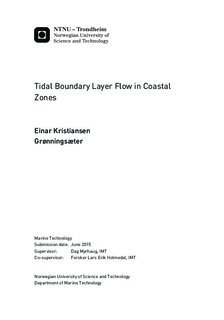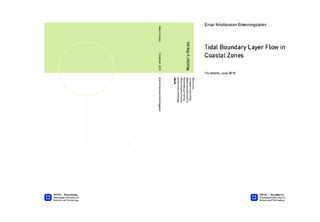| dc.description.abstract | A one-dimensional hydrodynamic model with a two-equation turbulence closure has been used to model shallow-water tidal flow over a complex bottom. The intention was to investigate the applicability of the model on tidal flow in coastal zones, where effects of bottom conditions and constrictions due to coastlines and underwater topography are important. This is of interest because near-shore tidal flows are important for transport of biological material and pollutants. In addition, the present model and similar models are time-efficient and require little computational power. The turbulence closure known as the k-epsilon model was used.
Field data of current velocities and surface elevation measured outside the coast of the Hebrides, Scotland, have been processed and applied to the model. Frequency spectra of the current was calculated, and the main tidal constituents were identified. The velocity signals were filtered digitally to remove components not related to the tides. It was found that such components were present also in the range of tidal frequencies. These components could not be removed.
The model was run with the filtered field velocities at a specific height above the bottom as input. The filtered velocities in four points through the water column were used as references to assess the model results. The effect of the specified bottom roughness was investigated. Impacts of wind and wave conditions and tidal range (the vertical distance between low and high tide) on the model's accuracy were assessed. The former is of interest because effects of atmospheric conditions are believed to make up the most part of current contributions not induced by tides in the filtered data. The latter is of interest because the model assumes a constant water depth.
A bottom roughness of 0.0006 cm was found to give the best results. With this roughness, the velocities at a specific vertical position was modeled with very good accuracy. The damping of the flow towards the bottom, however, was much smaller than in the field data. The damping in the field data is very strong. The main reason for this is believed to be the presence of tall seaweed at the bottom, together with boulders. It was found that the predicted boundary layer matched an empirical formula better than what the field data did. With a bottom roughness of 0.050 cm, the predicted boundary layer was a very good fit to the formula. The flow state was found to be hydrodynamically rough with this roughness, and smooth for a bottom roughness of 0.0006 cm, which also indicates that the former roughness gives a more realistic damping than the latter. The velocity profile described by the formula is constant through the upper half of the water column, unlike the profiles in the field data. The formula has previously been verified against field measurements including shallow-water flow. Hence, we know that tidal flows may exhibit such boundary layers also in shallow water.
A tendency indicating that increasing wave activity decreases the model s accuracy was found, but a conclusion could not be drawn, because the accuracy difference was small. So was the difference between periods of low and high tidal ranges. A tendency was found, however, that for high tidal ranges, the tidal ellipses were rotated clockwise relative to the field data. This corresponds to the conclusions of the pre-master project thesis.
The main conclusion is that the results are relatively good, the simplicity and efficiency of the model taken into account. In its present form, the model is not applicable for predictions of transport of biological material, pollutants or other material in the specific complex conditions in the present field data. However, the results indicate that the model might be able to model shallow-water tidal flow boundary layers with better accuracy than obtained here, if the conditions are less complex. It is proposed that further works may assess this indication, and address the different types of boundary layers found in coastal tidal flows. An attempt of implementing the effect of seaweed in the model could also be made, as this is assumed to be the main reason for the discrepancies between the field data and the model results. | |

